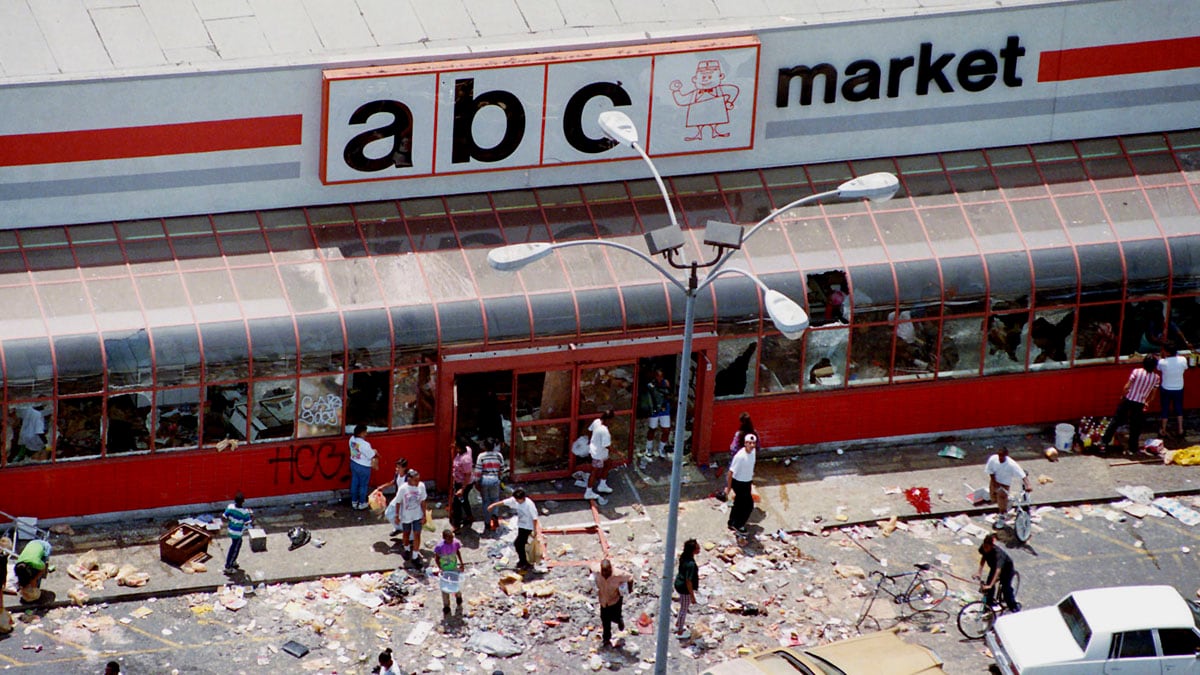Well before the Los Angeles riots broke out on April 29, 1992, Bob Tur knew what was missing from television news: images. Footage of what was happening as it was happening. Not shot from a news van or a cameraman’s shoulder, but from high above—from a helicopter.
Tur, who would go on to shoot some of the most important footage in the history of television news, was 21 years old when he began pitching his idea to L.A. television stations in the 1980s. None bit. But he spoke to the right people at Bell Helicopter Textron, and somehow wrangled himself a chopper. Looking for the most daring operators in the business, he took his training from the pilots at the Los Angeles Fire Department.
Through the 1980s, Tur’s lens, guided by his then-wife Marika Gerrard, captured news as it unfolded for their company, the Los Angeles News Service. So when the Los Angeles police officers who had been videotaped beating Rodney King were up for trial, Tur knew there was the potential for a major news event. In the weeks before the verdict was handed down, he was out on the street, talking to cops, gang members, and ordinary residents of Compton and South Central.
He asked members of the Eight Tray Gangster Crips what he could expect if a not guilty verdict were delivered. The streets would see their anger, the gangsters told him. And so on April 29, as the jury handed down acquittals, Tur was in his hangar at the Santa Monica airport, ready to go. A heavy silence followed the announcement, Tur recalled in an interview with The Daily Beast—eventually broken by his wife. “Let the beatings begin,” she said.
Defying his assignment-desk editor, who told him that there would be no violence, Tur took off in his American Eurocopter AS350 B2 with Gerrard, copilot Doug Denoff, and photographer Robert Clark. For fear that the LAPD and Federal Aviation Administration would try to shut down air space over the city, he also took along lawyer Matthew Fairshter. Flying low out over the city, Tur directed his aircraft to the intersection of Florence and Normandie avenues, where the Eight Tray Gangster Crips hung out at Tom’s Liquor. And then he circled.
About 45 minutes elapsed between the time he arrived above the intersection and the time the city exploded, Tur told The Daily Beast.
“It started with some rocks being thrown at passing motorists,” he said. “But then it escalated to Tom’s Liquor store being looted by people who lived in the community. They weren’t taking bottles; they were taking cases of liquor. Anger mixed with liquor is explosive. Within 30 minutes I watched a KNX news-radio van come under attack with bricks, rocks, and anything that wasn’t nailed down.”
Basketball fans were still headed to a game at the Coliseum, Tur knew, and as more vehicles were pelted with bottles and rocks, he warned viewers of his live broadcast on KCOP-TV Channel 13 to stay away from the flashpoint. It was clear, Tur said “that if you were any race other than black—and this includes Hispanic, Asian, white—you were in danger.”
From the air, it was plain to see that the situation on the ground was deteriorating quickly. He continued to circle, describing events to Americans at work and at home across the country, telling them what it looked like to watch a city destroying itself. Then people on the ground began shooting at him, Tur said. Still in shock that the LAPD had not made a show of force, he turned to Fairshter and joked, “If we get shot down, we’re shooting you in the leg. We’re running for it. We’re going to scream that you’re a lawyer.” Still, Tur didn’t leave, despite receiving direction to do so from both his news director and anchor. His helicopter sustained $154,000 worth of damage while he was reporting the story, he said.
Then, close to 6:45 p.m., a 33-year-old white driver for Transit Mixed Concrete decided he was going to take a shortcut off the Santa Monica Freeway. The driver and his 18-wheeler eased down the street toward where 19-year-old Damian Monroe Williams stood. The truck slowed, and then stopped.
“Once he stopped that truck, his fate was in stone,” Tur says.
The cab door was opened, and Reginald Denny was dragged from his truck. He was beaten and kicked repeatedly. Then, as Tur broadcast the savagery live, Williams, a one-time high school football star, threw a chunk of cinderblock with all his force against Denny’s skull. It fractured in 91 places.
Tur says he felt dead inside as he watched, knowing that he’d captured an image that would become iconic—and that there was nothing he could do to help the man bleeding out onto the street below as his assailants celebrated. Then the camera moved, and so did Tur’s attention. Another man approached, unscrewed the gas tank to Denny’s truck, and attempted to fire his shotgun into it.
The man wanted to “burn Mr. Denny alive,” Tur said. “We were watching a man being lynched in the streets.”
Tur says he knows now—and knew then—that his coverage was crucial to recording the events for history, and for showing America one of her largest cities committing suicide. Yet the coverage had some undesired consequences. “There was a dark side to the live coverage,” Tur says. Some looters were emboldened by the live images showing zero police presence at Florence and Normandie.

However, the live broadcast may have also saved Denny’s life. For while eager looters in the neighborhood were watching, so were Bobby Green, Lei Yuille, Terri Barnett, and Titus Murphy. After seeing Denny pummeled nearly to death, and with every reason to assume that the man had in fact been killed right there as Tur captured it on camera, the four went to the scene, put Denny back in his truck, and drove the nearly lifeless man to Daniel Freeman Memorial Hospital in Inglewood. Denny survived, despite having suffered severe brain damage.
After seeing Denny beaten, watching Green’s courageous actions “made me not lose hope,” Tur said. “Because really to see something like this could have turned me into a racist.” Time, Tur said, has helped him gain a sense of context. “What we saw at Florence and Normandie was not representative of the entire community. It was representative of a small number of the community, but not of all of the community.”
Tur was in the air for three days straight, he says. Sometimes, as he did when he saw Denny beaten, Tur said he would activate his helicopter’s onboard police siren to frighten off violent rioters, or at least let them know they were being caught on camera. It usually had little effect.
“Day became night,” Tur says, “and fires started occurring. We saw the first fire and then the next fire and then the next fire and then entire city blocks were burning. Flying at low altitude, you could see people, their faces lit by the firelight, and they were stealing anything they could possibly steal.”
Either 53 or 55 people died in the riots, depending on which count one goes by. Some 2,300 were injured. Tur would go on to tape the beating of another trucker, Larry Tarvan, who was pulled from his vehicle. Thousands of checks would pour into the Daniel Freeman Memorial Hospital to support Denny’s recovery, a slow and precarious process that took years. In 1993, Williams would be convicted of four misdemeanors and simple mayhem, and sentenced to serve 10 years, of which he served four. In 2003, he was sentenced to 46 years in Pelican Bay State Prison for the 2000 murder of a Los Angeles drug dealer.
Tur went on to win numerous journalism awards, and was the first to capture footage of O.J. Simpson’s white Bronco during the infamous 1994 car chase.
After the prosecution of Williams and Denny’s other assailants, prosecutors gave Tur the brick with which Williams crushed Denny’s skull. He keeps the “instrument of evil” locked in his office. To this day, he knows he gave the nation the riot’s indelible image, a bookend to the Rodney King tape that started it all.
“I had to do what I had to do,” Tur says of his rush to the intersection of Florence and Normandie 20 years ago. “The history was happening.”






